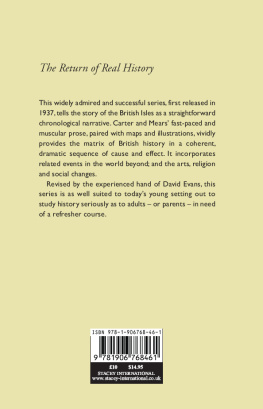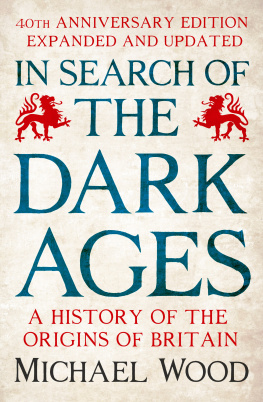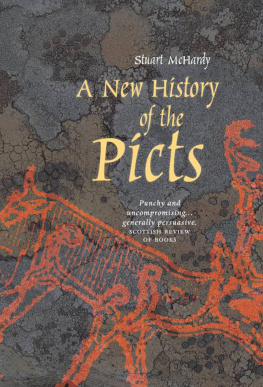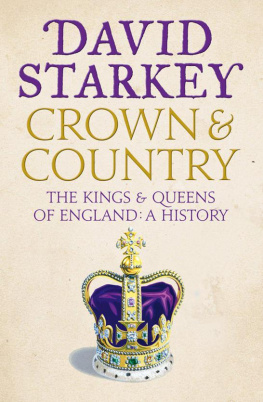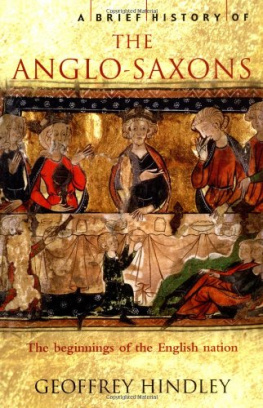A HISTORY OF BRITAIN
Book I
This first volume of the evolving series covers the history of the British Isles from post-Ice Age neolithic and Bronze Age settlements through the successive Roman, Saxon and Nordic invasions, to the defeat of Harold at the hands of William the Conqueror in 1066. Each encounter shaped our way of life, language, culture and heritage. Britain was enriched by the civilization of the Picts, Celts, Romans, Saxons and Vikings, and above all by the profound influence of Christianity which illuminated the so-called Dark Ages with its faith, arts, literature and liturgy. The period covered by this book is remote in time, indeed many of its tales Alfred burning the cakes, Cnut turning back the tide have passed into folklore. Yet a grasp of it is nonetheless important for anyone who seeks to understand Britain at the start of the third millennium.
EH Carter was Chief Inspector of Schools in the 1930s and 40s.
RAF Mears taught history at Warwick School between 1923 and 1933.
David Evans, who edits the restored series, is an historian and former Head of History at Eton College.
P UBLICATION S CHEDULE
| I. | Picts, Celts, Romans & Anglo-Saxons, to 1066 | Spring 2011 |
| II. | The Normans, the Black Death and the Peasants Revolt 1066-1485 | Autumn 2010 |
| III. | The Tudors: Henry VII to Elizabeth I, 1485-1603 | Spring 2010 |
| IV. | The Stuarts, Cromwell and the Glorious Revolution, 1603-1714 | Spring 2010 |
| V. | The Age of Reason and the Industrial Revolution, 1714-1832 | Autumn 2010 |
| VI. | The Victorians and the Growth of Empire, 1832-1901 | Spring 2011 |
| VII. | Liberal England, World War and Slump, 1901-1939 | Autumn 2011 |
| VIII. | The Second World War and its Aftermath, 1939-1951 | Autumn 2011 |
A HISTORY OF BRITAIN
Picts, Celts, Romans & Anglo-Saxons
to 1066
by
EH Carter & RAF Mears
edited and updated by
David Evans

A H ISTORY OF B RITAIN
Picts, Celts, Romans & Anglo-Saxons
STACEY INTERNATIONAL
128 Kensington Church Street
London W8 4BH
Tel: +44 (0)20 7221 7166; Fax: +44 (0)20 7792 9288
Email:
www.stacey-international.co.uk
ISBN: 9781906768461
eISBN: 9781906768782
This version Stacey International 2011
Original edition published in 1937 by The Clarendon Press
1357908642
Printed in the United Kingdom
The Publishers of this edition of The History of Britain, revised by David Evans (formerly Head of History, Eton College), give wholehearted acknowledgment to the original work of the late E H Carter (sometime Chief Examiner in History, Board of Education, and H M Inspector of Schools) and R A F Mears (former Senior History Master, Warwick School), who died respectively in 1954 and 1940. The Publishers declare that prolonged endeavours devoted to tracing whether rights to the work of these two distinguished scholars rested with any successors or assigns have been made.
Maps by Amber Sheers
CIP Data: A catalogue record for this book is available from the British Library
All rights reserved. No part of this publication may be reproduced, stored in a retrieval system, or transmitted in any form or by any means, electronic, mechanical, photocopying, recording or otherwise, without the prior permission of the copyright owner.
Contents
List of Illustrations
Maps
Glossary
| Latin terms |
| civitas (plural civitates) | territory based on a city, usually a tribal territory |
| colonia (plural coloniae) | settlement of veteran Roman soldiers |
| Anglo-Saxon terms |
| bretwalde | broad ruler |
| burh | garrisoned defensive centre |
| dux | leader |
| ealdorman | royal official in charge of a territory (the word fell out of use in the 11th century, replaced by earl) |
| fyrd | the army produced by calling out all able-bodied free men |
| geld | gold, money |
| thegn | landowner of noble status |
| witan | the great men of the kingdom (literally wise men) |
| welsch | foreigners |
| vergild | status value |
| English terms |
| canonize | make a saint |
| celibate | pledged to remain unmarried |
| celibacy | the state of remaining unmarried |
| chaste | living without engaging in sexual relations |
| diocese | the area of which a bishop is spiritual head |
| illuminated manuscript | hand-written text with painted illustrations |
| maenad | wild female follower of Bacchus, god of wine |
| mosaic | use of small pieces of coloured stone, tile or glass to make a design on a floor, wall or ceiling |
| p-Celtic | form of Celtic spoken in Wales, Cornwall, Brittany and formerly Britain |
| q-Celtic | form of Celtic spoken in Ireland and Scotland |
| Romanesque | architectural style, flourishing c.900-1150. |
| Features: round arches, massive walls |
| satyr | woodland creature, part man, part goat |
| vassal | someone who owes homage and military service |
| to a lord |
| vellum | goat- or sheep-skin used as a material for writing on |
O UTLINE S UMMARY:
(55 BC AD 1066)
ROMAN PERIOD (55 BC C. AD 450) |
| B RITISH ISLES | A BROAD |
| 55-4 BC Caesars expeditions |
| 30 BC - AD 14 Augustus, First Roman Emperor |
| AD 43 Roman conquest begins |
| 47-56 AD St. Pauls Missionary Journeys |
| 121 Hadrians visit |
| 306-37 Constantine, First Christian Emperor |
| 410-50 Britain cut off from Rome | 410 Sack of Rome by Goths |
SAXON PERIOD (c. 450-1066) |
| c.450-500 Anglo-Saxon invasions | 476 Last Roman Emperor of the West |
| 597 St Augustine lands | 590-604 Pope Gregory the Great |
| 632 Mahomet d. |
| 800 Charlemagne crowned Emperor |
| 871-900 Alfred the Great |
| 962 Otto crowned Holy Roman Emperor |
| 1016-35 Cnut (Dane) King |
| 1042-66 Edward the Confessor |
| 1066 Harold d. |
I
B EFORE THE R OMANS
1. Cheddar Man
T HIS book and its sequels in the series seek to trace the history of the peoples who have lived in the archipelago off the north-west coast of Europe, the largest islands of which are called, in modern English, Britain and Ireland. It is now believed that the species known as homo sapiens originated in Africa and from there gradually spread to other continents. The earliest human remains found in the archipelago date from a period before the last Ice Age when the islands were part of a large peninsula jutting out from Europe. During the Ice Age human settlement in this peninsula ceased for several millennia, but it resumed about twelve thousand years ago. Remarkable evidence of this resettlement was found in 1903, when the bones of a young man were discovered interred in a cave in Cheddar Gorge, Somerset. By use of the radio-carbon method, his remains were dated to about nine thousand years ago. He was found surrounded by thousands of flints used as spears, knives and scrapers, as well as by the bones of birds and animals such as wild horse, pig, deer and bear, which must have formed his diet.
Next page
